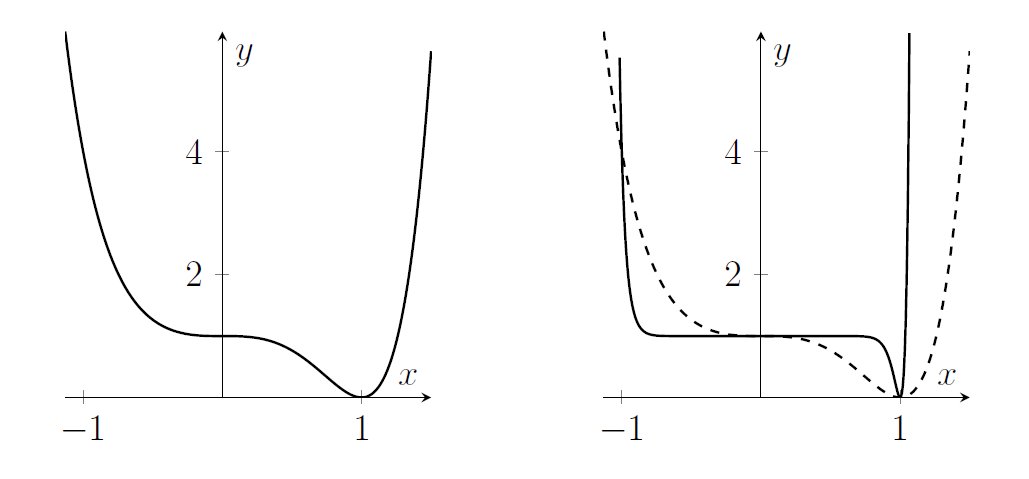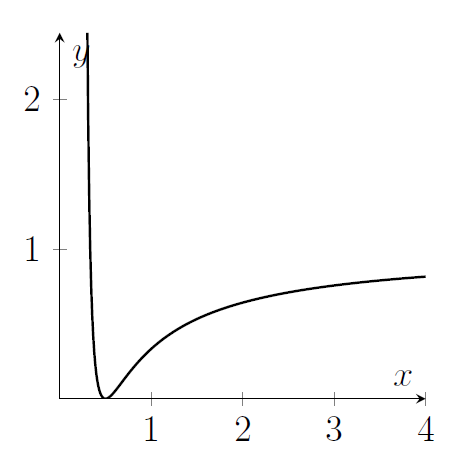Integration Solutions
Part of the Oxford MAT Livestream.
Revision Questions
- The derivative of $x^a$ is $ax^{a-1}$ so the derivative of this expression is $17x^{16}+17x^{-18}$.
- Remember that $\sqrt{x}=x^{1/2}$ and $\sqrt[3]{x}=x^{1/3}$, so the derivative of this expression is $x^{-1/2}+x^{-2/3}$, which we could write as \(\displaystyle\frac{1}{\sqrt{x}}+\frac{1}{x^{2/3}}\) if we wanted to.
- Remember that the derivative of a constant is $0$, so the derivative of this expression is just $-3e^{3x}$.
- We need to find the value of the derivative $\displaystyle\frac{\mathrm{d}y}{\mathrm{d}x}$ at $x=2$ because that's equal to the gradient of the tangent. We can differentiate to find $\displaystyle\frac{\mathrm{d}y}{\mathrm{d}x}=e^x+2x$ so that gradient we wanted is $e^2+4$. We also want the tangent to have the same value at $x=2$ as the curve; that's $e^x+x^2$ at $x=2$, which is also $e^2+4$. So our tangent is $y=(e^2+4)(x-1)$.
- First find the derivative at $x=3$, which is $6$ for this parabola. That's the gradient of the tangent, and the normal is at right-angles to the tangent, so it has gradient $\displaystyle -\frac{1}{6}$. We have $\displaystyle y=-\frac{x}{6}+c$ and we want the normal to go through the point $(3,9)$. So we want $\displaystyle c=\frac{19}{2}$.
- The turning points must have $\displaystyle\frac{\mathrm{d}y}{\mathrm{d}x}=0$ so we must have $4x^3-6x^2+2x=0$. That happens when $x=0$ or when $2x^2-3x+1=0$ which happens when $(2x-1)(x-1)=0$, which is either $x=1$ or $x=\frac{1}{2}$.
Now find the second derivative to check whether these are minima or maxima. We have $\displaystyle \frac{\mathrm{d}^2y}{\mathrm{d}x^2}=12x^2-12x+2$, which is positive for $x=0$, negative for $x=\frac{1}{2}$, and positive for $x=1$. So we have a (local) minimum, then a (local) maximum, then a (local) minimum.
The function is decreasing for $x<0$, then increasing for $0<x<\frac{1}{2}$, then decreasing for $\frac{1}{2}<x<1$ then increasing for $x>1$. - The line definitely goes through $A$, which doesn't move. The thing we learn from "differentiation from first principles" is that the gradient of the line gets closer and closer to the derivative of the function at $A$.
The derivative is $3x^2+2x+1$ which is 6 at $x=1$. The value is $4$, so the tangent is $y=6x-2$. So if the line through $A$ and $B$ is $y=mx+c$ then $m$ gets closer and closer to 6 and $c$ gets closer and closer to $-2$. - First find the points where $y=0$. We have $(x+3)(x+1)=0$ so these points are at $x=-1$ or $x=-3$. In between, we have $y<0$ (by considering the graph).
So we want $-\displaystyle \int_{-3}^{-1} x^2+4x+3\,\mathrm{d}x$. That minus sign out the front is because the function is negative in this region. This works out to be $\displaystyle \frac{4}{3}$. -
- $\displaystyle \int \frac{x+3}{x^3}\,\mathrm{d}x=\int \frac{1}{x^2}+\frac{3}{x^3},\mathrm{d}x=-\frac{1}{x}-\frac{3}{2x^2}+c$ where $c$ is a constant.
- $\displaystyle \int \sqrt[3]{x}\,\mathrm{d}x=\int x^{1/3}\,\mathrm{d}x=\frac{3}{4}x^{4/3}+c$ where $c$ is a constant.
- $\displaystyle \int \left(\left(x^2\right)^3\right)^5\,\mathrm{d}x=\int x^{30}\,\mathrm{d}x=\frac{x^{31}}{31}+c$ where $c$ is a constant.
- $\displaystyle \int \left(x^2+1\right)^3\,\mathrm{d}x=\int x^6+3x^4+3x^2+1\,\mathrm{d}x=\frac{x^7}{7}+\frac{3x^5}{5}+x^3+x+c$ where $c$ is a constant.
- The graph of $f(-x)$ is the graph of $f(x)$ reflected in $y$-axis. Also, note that if we reflect the interval $-1\leq x \leq 1$ in the $y$-axis then we get the same interval back. On the left-hand side, we're finding the area under $f(x)$ (or maybe negative the area in any regions where $f$ is negative). On the right-hand side, we're calculating exactly the same area, but with the shape of the graph reflected.
- First consider the graph $\displaystyle y=\frac{1}{x}$. The area under the graph between $x=1$ and $x=10$ is $I_1$. Now consider stretching that region by a factor of 10 parallel to the $x$-axis, and squashing it by a factor of 10 parallel to the $y$-axis. The area will be the same, and (amazingly!) any point that was on the curve $\displaystyle y=\frac{1}{x}$ is still on the graph after these transformations. So $I_2$, the area under the graph between $10$ and $100$ is equal to $I_1$.
This means that $$\int_1^{100}\frac{1}{x}\,\mathrm{d}x=\int_1^{10}\frac{1}{x}\,\mathrm{d}x+\int_{10}^{100}\frac{1}{x}\,\mathrm{d}x=I_1+I_2=2I_1.$$
But similarly, if we think about stretching the graph again in the same way, we find that $\displaystyle \int_{100}^{1000}\frac{1}{x}\,\mathrm{d}x$ is also equal to $I_1$. By setting $N$ to be a large power of ten, we can make $\displaystyle \int_1^{N}\frac{1}{x}\,\mathrm{d}x$ arbitrarily large. - Note that $\displaystyle \frac{x^2}{1+x^2}+\frac{1}{1+x^2}=1$ so $I_3+I_4=\int_1^3 1 \,\mathrm{d}x=2$. So $I_3+I_4=2$.
- Note that $\displaystyle \frac{x^4}{1+x^2}=x^2-\frac{x^2}{1+x^2}$ so this new integral is $\displaystyle \int_1^3 x^2\,\mathrm{d}x-I_4=8\frac{2}{3}-I_4$.
MAT Questions
MAT 2017 Q1A
- Stationary points at those values of $x$ for which the derivative of $f(x)$ is zero. So we're looking for points where $6x^2-2kx+2=0$
- We would like to know whether or not there are two distinct values of $x$ that satisfy that equation. It's a quadratic equation.
- We should check the discriminant. If $(2k)^2-4\times 6\times 2>0$ then there are two distinct real solutions.
- That inequality simplifies to $k^2>12$. This is true when either $k>\sqrt{12}$ or when $k<-\sqrt{12}$.
- The answer is (b).
MAT 2018 Q1A
- The curve and the line have the same value where $\sqrt{x}=x-2$. We could square both sides to find that $x=(x-2)^2$, so $x^2-3x+4=0$. The solutions to that equation $x=4$ and $x=1$. But we should check our answers; $\sqrt{1}=1$ and $1-2=-1$, so $x=1$ is not a solution. The point with $x=4$ is a genuine solution, because $\sqrt{4}$ really is equal to $4-2$.
- If we integrate $\sqrt{x}$ from 0 to 4, we would get the area between the curve $\sqrt{x}$ and the $x$-axis, in the region $0<x<4$. We want something slightly different, because we don't want the bit of that area which is under the line $y=x-2$.
- That area under the line $y=x-2$ is a right-angled triangle with base 2 and height 2, so it has area 2. (We could integrate from 2 to 4 to get that area, but I know a formula for the area of a triangle).
- So we just need $\int_0^4 \sqrt{x}\,\mathrm{d}x-2$.
- Time for some integration; $$\int_0^4 \sqrt{x}\,\mathrm{d}x-2=\left[\frac{2}{3}x^{3/2}\right]_0^4-2=\frac{16}{3}-2=\frac{10}{3}.$$
- The answer is (d).
MAT 2018 Q1G
- We can write the second curve as $y=\pm\sqrt{x}$. The curve only exists where $x>0$, and in that region the first curve $y=x^2+c$ has positive gradient. So the gradient will only match if we consider the part of the second curve where $y=+\sqrt{x}$ with a $+$ sign.
- Now we can match up the values of the curves, and separately match up the gradients of the curves, for the system of equations; $$ x^2+c=\sqrt{x},\qquad 2x=\frac{1}{2}\frac{1}{\sqrt{x}}, $$ where by $x$, I mean the particular value of $x$ at the point where the curves meet. (Really I should give that value of $x$ a name, I'm being lazy with my notation here)
- I can solve the second equation for $x=4^{-2/3}$. Then substituting that value into the first equation gives me $c=\sqrt{4^{-2/3}}-\left(4^{-2/3}\right)^2$.
- This simplifies to $c=4^{-1/3}-4^{-4/3}$.
- Most of the options are a single expression, so I'm looking for a way to simplify further. Eventually I spot that $\frac{4}{3}=1+\frac{1}{3}$, so the second term in my expression is $4^{-1}4^{-1/3}$
- So $c=\frac{3}{4}\times4^{-1/3}$
- The answer is (b).
MAT 2009 Q3
(i) The function inside the brackets is $x^3-1$. That's $0$ at $x=1$ and it's $-1$ at $x=0$. It's negative for $x<1$. Here's my sketch of the square of that function, on the left below.

(ii) For higher powers of $n$, the function $x^{2n-1}$ is approximately zero for $|x|<1$, and it grows rapidly outside that range. So $x^{2n-1}-1$ is about $-1$ for the range $|x|<1$, but it shoots up to high positive values soon after $x=1$ and it shoots down to very negative values just before $x=-1$. If we square that function, we'll get something that's about $1$ for most of the range $|x|<1$, but near the edges of that region two strange things will happen. Near $x=-1$, the function inside the brackets just gets really negative. For $x$ near $1$, the function inside the brackets increases to zero then increases to high positive values. For the square of the function, this is a decrease to zero first, then an increase to high positive values. See my sketch above, on the right, with the dashed line indicating my previous sketch.
(iii) We have $$ \int_0^1 f_n(x)\,\mathrm{d}x=\int_0^1 x^{4n-2}-2x^{2n-1}+1\,\mathrm{d}x=\left[\frac{x^{4n-1}}{4n-1}-\frac{x^{2n}}{n}+x\right]_0^1=\frac{1}{4n-1}-\frac{1}{n}+1$$
where the contributions from the lower limit $x=0$ are all zero because those powers of $x$ give zero for $n\geq 1$ a whole number.
(iv) We would like $$ 1+\frac{1}{4n-1}-\frac{1}{n}\leq 1-\frac{A}{n+B}$$ for all $n\geq 1$. This rearranges (being careful not to multiply by negative numbers) to the inequality $$ 0\geq (4A-3)n^2+(1-A-3B)n+B $$
If the coefficient of $n^2$ is positive, this clearly doesn't work (because the right-hand side will get really large and positive for large enough $n$), so we must have $A\leq 3/4$.
(v) If the coefficient of $n^2$ is zero, then $A=3/4$. We still need $$ 0\geq \left(\frac{1}{4}-3B\right)n+B$$ for all $n\geq 1$. For this to work, the linear function on the right-hand side must have negative or zero gradient, and the value at $n=1$ must be negative or zero. We therefore require both $B\geq 1/12$ and also $B \geq 1/8$. Since we need both of these to hold, we must have $B\geq 1/8$.
Quick check that if $A=3/4$ and $B=1/8$ then the inequality is in fact true.
Extension
- If $n=1/2$ then the function is constant and zero. The integral is zero.
- We need $n> 1/4$. If $n\leq 1/4$ then the integral doesn't exist, because $x^{4n-1}$ gets very large near $x=0$.
- Sketch:

MAT 2015 Q3
(i) There are lots of choices that work! To keep things simple, I picked constant functions $f(x)=\frac{1}{200}$ and $g(x)=0$. Then $|f(x)-g(x)|$ is less than $\frac{1}{100}$, but not less than $\frac{1}{320}$.
(ii) In this case, $f(x)-g(x)=\sin(4x^2)/400$. The $4x^2$ inside the brackets doesn't really matter; whatever the value of $\theta$, we have $|\sin(\theta)|<1$. So in this case we have\\ $|f(x)-g(x)|\leq 1/400$, which is less than $1/320$ for all $x$.
(iii) I can integrate for $\displaystyle g(x)=1+x+\frac{x^2}{2}+\frac{x^3}{6}+\frac{x^4}{24}$.
The value of $|g(x)-f(x)|$ is $x^4/24$, but that can only be as large as $(1/2)^4 / 24$, and that's less than $1/320$.
(iv) I'd like something involving $h(x)$ and $g(x)$, so that they appear on opposite sides of the equation. I'll take the difference between the defining equations for $h(x)$ and $g(x)$ for $$h(x)-g(x)=1-1+\int_0^x h(t)\,\mathrm{d}t - \int_0^x f(t)\,\mathrm{d}t.$$ This rearranges to the target expression, if I subtract $f(x)$ from both sides.
(v) There's a given range for $x$. The largest value of the integral would come if, hypothetically, $x=\frac{1}{2}$ and if $h(t)-f(t)$ were equal to its maximum value of $h(x_0)-f(x_0)$ all the way from $t=0$ to $t=\frac{1}{2}$. That would give an area of $\frac{1}{2}\times (h(x_0)-f(x_0))$.
(vi) We've been told that $h(x)\geq f(x)$, so $h(x)-f(x)\geq 0$. We just need to check that $h(x)-f(x)\leq 1/100$. It's enough to check that the maximum value $h(x_0)-f(x_0)$ is less than $1/100$.
In part (v) we worked out a fact about the integral in part (iv). Together, we have $$h(x)-f(x)\leq g(x)-f(x)+\frac{1}{2}\left(h(x_0)-f(x_0)\right).$$
But if we set $x=x_0$ and rearrange, this shows that $\frac{1}{2}\left(h(x_0)-f(x_0)\right)\leq g(x_0)-f(x_0)$. And we know from part (iii) that the last expression there is less than $1/320$. So the expression $h(x_0)-f(x_0)$ is less than $1/100$ and we have a good approximation.
Extension
- If $h(t)=e^t$ then the right-hand side is $1+\int_0^x e^t\,\mathrm{d}t=1+\left[e^t\right]_0^x=e^x.$
- Perhaps we could try $h(x)=A e^{kx}$. Then the right-hand side becomes
$$2+\int_0^x 3 Ae^{kt}\,\mathrm{d}t=2+\left[\frac{3Ae^{kt}}{k}\right]_0^x=2+\frac{3A}{k}\left(e^{kx}-1\right).$$
If $k=3$ and $A=2$ then this simplifies to $2e^{3x}$ which is $h(x)$.
So $h(x)=2e^{3x}$ is a solution.

